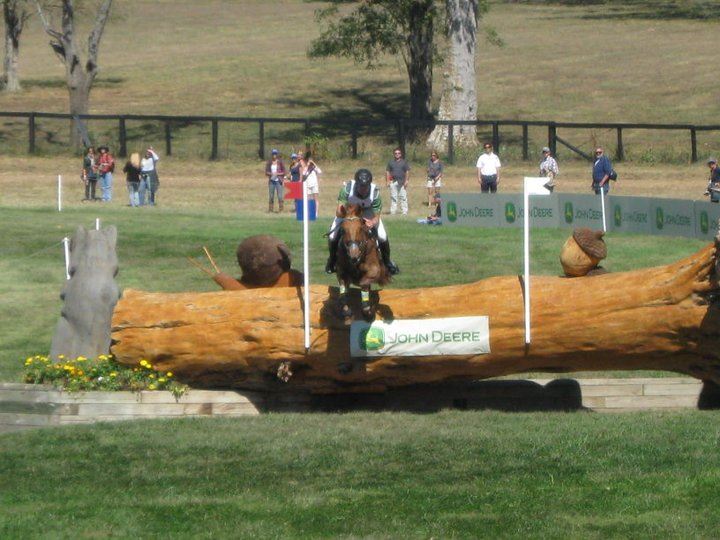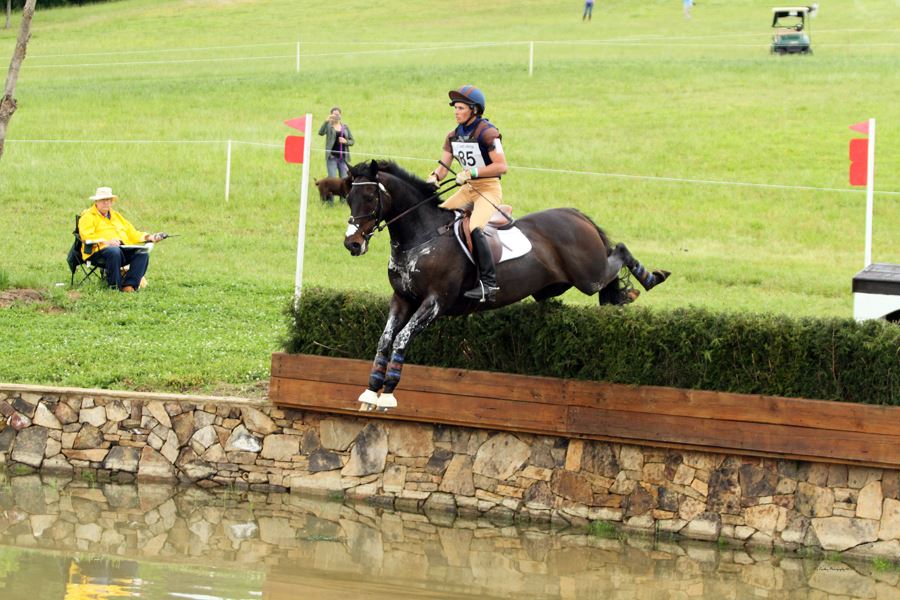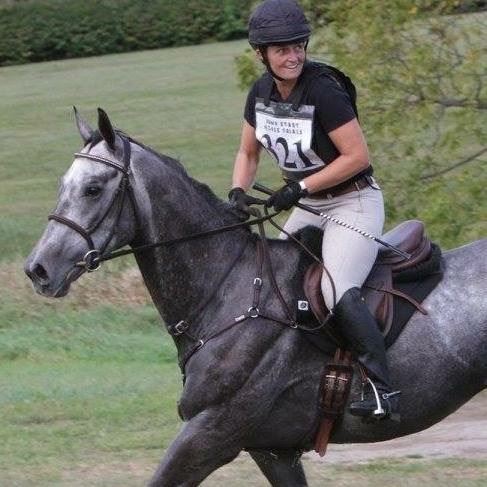
The following rules have been proposed or enacted for the 2017 competition year for the eventing discipline:
Read more here.
EV172 Additional Judges [CHAPTER EV-6 RULES FOR OFFICIALS] EV172
Additional Judges
1. In addition to the Ground Jury, the Organizing Committee may appoint additional judges to judge the Dressage or Jumping Tests. These judges need not remain after completion of their duties.
2. Additional judges for the Dressage Test must be selected from the current roster of Eventing Judges or Dressage Judges of the Federation. In the case of an Advanced Horse Trial, they must be either a Senior (S) Eventing Judge or a Registered (R) or higher Dressage Judge. In the case of an Intermediate Horse Trial, they must be either a Registered (R) or higher Eventing Judge or a recorded (r) or higher Dressage Judge.
3. Additional judges for the Jumping Test must be selected from the current roster of Eventing Judges, Eventing Technical Delegates or Jumper Judges, of the Federation.
4. All additional judges are subject to the same restrictions as the members of the Ground Jury, see EV171.1c, EV171.1d, and EV171.1e with the exception to EV171.1e, that the Course Designer may serve as an additional judge if currently licensed to do so.
5. Guest Cards (see GR1011.16)
The provisions of GR1304 notwithstanding, additional judges may officiate at a competition provided that they do not judge any competitor(s) or horse(s) listed in sections .2-.18 of that rule. There are no restrictions on a Judge if a competitor(s) or horses(s) listed in GR1304.2-.18 participates in the Competition HC.
EV172.2 a) Ground Jury - Duties [CHAPTER EV-6 RULES FOR OFFICIALS]
Ground Jury
2. DUTIES: a. The Ground Jury is ultimately responsible for the judging of the event and for settling all problems that may arise during its jurisdiction. Together with the Technical Delegate, Course Designer and Organizing Committee, it shall endeavor to ensure that all arrangements for the event, including the arenas, courses and obstacles including deformable Cross-Country Jumps, are appropriate. If, after consultation with the Technical Delegate, the Ground Jury is not satisfied with the arrangements or courses, it is authorized to modify them.
Proposed change to take place on April 1, 2017: Safety: Frangible Fences
EV140 Cross-Country Obstacles [CHAPTER SUBCHAPTER EV-3 RULES FOR HORSE TRIALS]
9. FRANGIBLE FENCES Obstacles for which approved frangible technology is appropriate shall be constructed using this technology, or shall be retrofitted using this technology. The Ground Jury for each event must approve the Frangible Technology employed. Information on the appropriate applications of Frangible Technology in cross-country fence construction is available in the USEA Cross-Country Obstacle Design Guidelines. Frangible Technology may be installed only by or under the supervision of Course Designers/course builders who have attended a USEA Seminar on Frangible fence construction.
b. At the Modified Level and above, all frangible oxers, whether using frangible pins, MIM Clips, or any other load relieving devices, shall in all cases have front rails able to be activated by horizontal and vertical downwards forces, as well as horizontal and vertical upwards forces. Additionally, the back rails must at a minimum be able to be activated by horizontal and vertical downwards forces.
Intent:
The USEA Cross-Country Safety and Design Task Force has proposed an extraordinary rule change, which has been further supported unanimously by the USEA Executive Committee. Engineers, cross-country course designers, cross-country builders, eventing officials and professionals have been conducting extensive observational research in person, by video and by photograph of horse and rider impact on oxers constructed with frangible devices. Those involved in this research have determined that when a horse impacts the front rail of a frangible oxer in an upwards and horizontal trajectory there is a high probability that an oxer with a front rail that is either front pinned or reverse pinned will fail to activate the frangible device or it will activate in a less than ideal fashion to reduce the possibility of a rotational fall. With this conclusive evidence the USEA Executive Committee feels that an extraordinary rule change is necessary to help to further protect the safety of eventing horses and riders.
This rule change would require both the front and back rails of frangible oxers using pins, MIM clips or other load bearing devices, be activated by specified forces. To be in compliance with this rule change using present frangible technology, builders must use MIMS on front rails and MIMS or reverse pin on back rails. While current technology is available to meet this standard, the language will also allow for future frangible devices. This is a change that will most likely occur in the near future through the FEI, and it is important for the U.S. to be a leader in regulations that will ultimately protect our national competitors and horses. If this rule passes, the USEA Board of Governors may also be amenable to releasing funds to offset the costs of course builders obtaining replacement frangible devices for oxers not currently meeting this standard at recognized and endorsed competitions thereby lessening the overall burden in implementation.
Read more here.

Extraordinary Rule Change:
EV105 Loss of Qualification/Participation in Horse Trials [CHAPTER Chapter 1 & Appendix 3]
EV105 Loss of Qualifications
For certain levels of competition, horses and riders must meet qualifying requirements. Those requirements are detailed in Appendix 3. Loss of these requirements (qualifications) is outlined below and pertains to any combination of USEF and FEI Events.
1. ESTABLISHMENT OF QUALIFICATION. When a horse and/or rider obtains a Minimum Eligibility Requirement (MER) at a level, then they are “established” (qualified to compete) at that level. This “establishment” does not expire; however, it is important to remember that in all cases, when entering an Event at the CI1* level or above, at least one MER must be obtained in the 12month period prior to the competition.
2. LOSS OF QUALIFICATION (Preliminary/CI* Level and up) Loss of Qualification will occur when penalties have been assessed during the Cross-Country phase of competition as follows:
a. A horse that is eliminated, for disobediences, three times within any 12-month period loses its qualification to compete at the highest level at which an elimination occurs.
b. A horse that falls 2 times in any 12month period loses its qualification Monday, December 12, 2016 1:23 PM EV 105.0 | Tracking #418-16 Page 1 of 8 to compete at the highest level at which a fall occurs.
c. A rider who falls from the same horse 3 times in any 12month period will cause the horse to lose its qualification to compete at the highest level at which a fall occurs.
d. Having lost qualification, a horse may be re-qualified by achieving 2 MERs at the next lower height level within any 6 month period and no sooner than one month following the loss of qualification.
e. Any combination of three total occurrences as outlined in a., b., or c above will result in loss of qualification.
f. A rider who is penalized 2 times in any 12month period for Dangerous Riding loses his/her qualification to compete at the highest level at which a penalty occurs
g. A rider who receives two watch list reports in a 12month period loses qualification to compete at the highest level for which a report was received.
h. Having lost qualification, a rider may be re-qualified by achieving 2 MERs at the next lower height level within any 6month period and no sooner than one month following the loss of qualification.
i. Any combination of two total occurrences as outlined in f. and g. above will result in loss of qualification.
3. At the Advanced, CI3*and CI4* levels, riders subject to the provisions of this rule may request in writing to have their Loss of Qualifications reviewed by the USEF Eventing Credentials Committee.
APPENDIX 3 - PARTICIPATION IN HORSE TRIALS
A competitor and/or a horse may be entered in a Horse Trial without having fulfilled the qualifications noted below, provided the qualifications have been fulfilled at least 10 days before the Cross-Country Test of the competition for which it is needed if the MER has been achieved at a Horse Trial or CIC or at least 24 days if the MER has been achieved at a CCI. At the CI* level and above, at least one MER must be obtained in the twelve month period prior to the competition. e.g. a horse and/or rider who have achieved a MER at a CI3*/CNC3* level of competition and who have not competed for over twelve months must first achieve a MER at the next lowest height level.
1. SECTIONS
1.1 JUNIOR (J) - For the purpose of competing in National Horse Trials competitors may compete as Juniors through the end of the calendar year of their 18th birthday.
1.2 YOUNG RIDER (YR) - Open to competitors from the beginning of the calendar year of their 16th birthday through the end of the calendar year of their 21st birthday.
1.3 AMATEUR (A) The following may participate in Eventing competitions as an Amateur:
a. Any competitor in possession of a valid Amateur card issued by the USEF, or
b. Any Senior USEA member who competes in the Training, Novice or Beginner Novice Level who meets the requirements of Federation GR1306. Individuals declaring such status must present, upon demand, an audited financial statement in support of the claim of eligibility; failure to do so will be deemed a violation. Misrepresentation of eligibility under this provision will subject an individual to disciplinary action under GR1307.6, GR1307.8, GR1308.3 and Chapter 6. Amateur certification under this provision is valid for Eventing competitions only and does not confer Amateur status for participation in any other Breed or Discipline.
1.4 For the purposes of this rule, in differentiating eligibility for Horse and Rider sections, FEI divisions are considered to be one level higher than the equivalent National division, e.g. FEI One Star is one level higher than a Preliminary Horse Trial. A rider who has completed an event at the Advanced Level is not eligible to compete as an Intermediate rider.
1.5 RIDER (R) - Open to competitors who have not completed an event above the next highest level in the 5 years preceding the date of the competition, e.g. a Novice Rider may have completed an event at Training level, but not Preliminary level or higher in the 5 years preceding the date of the competition; a Training Rider may have completed an event at Preliminary level, but not Intermediate level or higher in the 5 years preceding the date of the competition.
1.6 HORSE (H) - Open to competitors of any age, horse may not have completed an event above the next highest level. e.g. a Novice Horse may have completed an event at Training level, but not Preliminary level or higher; a Training Horse may have completed an event at Preliminary level, but not Intermediate level or higher.
1.7 YOUNG HORSE (YH) - Open to competitors of any age, horse may not have competed above the level and meets the following age restrictions:
a. Novice - four or five years of age.
b. Training - four or five years of age.
c. Preliminary - five or six years of age.
d. Intermediate - six or seven years of age.
e. Advanced - six or seven years of age. 1.9 OPEN (O) - Both horse and rider may have competed at any level.
1.10 CHAMPIONSHIP (CH) - open to all qualified riders on qualified horses.
1.11 OTHER - Restricted by breed or other designation as defined by Organizing Committee, approved by the Federation/USEA, and designated in the Omnibus listing
2. DEFINITIONS
2.1 Completion: means having completed the entire Horse Trial with a numerical score.
2.2 Minimum Eligibility Requirement
2.2.1 When achieved at a National Horse Trials an MER is achieved by completing the entire Horse Trial and scoring. -not more than 50 penalty points in the Dressage Test; and - No jumping penalties at obstacles on the Cross Country Test unless specified otherwise, and not more than 90 seconds (36 penalty points) exceeding the optimum time; and - not more than 16 penalties at obstacles in the Jumping Test. -25 penalty points received for Dangerous Riding will not achieve a National Qualifying result. Exceptions to the qualifications noted below may only be approved by the Credentials/Grading Committee.
2.2.2 When achieved at an FEI Competition an MER is achieved by completing the entire Horse Trial and scoring. -not more than 67 penalty points in the Dressage Test; and - No jumping penalties at obstacles on the Cross Country Test unless specified otherwise, and not more than 75 seconds (30 penalty points) exceeding the optimum time for one, two and three star competitions and 100 seconds (40 penalty points) exceeding the optimum time for four star competitions; and - not more than 16 penalties at obstacles in the Jumping Test (see Article 517 of the FEI Eventing Rules).
2.3 Uncategorized Rider: Riders who have not been categorized through proven competence at certain levels of competition i.e. A rider, B riders, etc. by the FEI per Article 520 of the FEI Eventing Rules for the purpose of determining rider eligibility for International Horse Trials and Events). All requirements of the FEI must be achieved as a combination. Where FEI requirements refer to a “CI” this may be satisfied by achieving an MER at a CCI or CIC of the level stated. When multiple Minimum Eligibility Requirements are required, one of the Minimum Eligibility Requirements can be achieved incurring 20 penalties at the obstacles of the Cross Country Test. All USEF requirements do not need to be achieved as a combination.
2.4 Categorized Riders: Riders who have been categorized through proven competence at certain levels of competition A riders, B riders, etc. by the FEI per Article 520 of the FEI Eventing Rules for the purpose of determining rider eligibility for International Horse Trials and Events. Where FEI requirements refer to a “CI” this may be satisfied by achieving an MER at a CCI or CIC of the level stated. When multiple Minimum Eligibility Requirements are required, one of the Minimum Eligibility Requirements can be achieved incurring 20 penalties at the obstacles of the Cross Country Test. All USEF requirements do not need to be achieved as a combination.

3. LEVELS OF HORSE TRIALS AND EVENTS
3.1 BEGINNER NOVICE (B) - Open to competitors of any age, on horses four years of age and older.
3.2 NOVICE (N) - Open to competitors of any age, on horses four years of age or older.
3.3 TRAINING (T) - Open to competitors of any age, on horses four years of age or older.
3.4 MODIFIED (M) – Open to competitors of any age, on horses four years of age or older. The competitor must have obtained an NQR at two Horse Trials at the Training Level or higher.
3.5 PRELIMINARY (P) - Open to competitors from the beginning of the calendar year of their 14th birthday, on horses five years of age or older. The competitor must have obtained an MER at four Horse Trials at the Training Level or higher.
3.6 TRAINING THREE-DAY EVENT- Open to competitors of any age, on horses four years of age or older. Both the competitor and the horse must have obtained ME’s at Four Horse Trials at the Training Level or higher, one of which must be attained as a combination. A competitor established at the Preliminary Level may compete on a horse which has obtained 2 MER’s at the Training Level or higher.
3.7 PRELIMINARY THREE-DAY EVENT- Open to competitors beginning the calendar year of their 14th birthday, on horses five years of age or older. Both the competitor and the horse, though not necessarily as a combination, must have obtained an MER at three Horse Trials at the Preliminary Level or higher, plus an additional MER at the Preliminary Level or higher with no more than 20 Jumping Penalties at obstacles on the Cross Country test.
3.8 INTERMEDIATE (I) - Open to competitors from the beginning of the calendar year of their 16th birthday, on horses six years of age or older. Both the competitor and the horse, though not necessarily as a combination, must have obtained an NQR at three Horse Trials at the Preliminary Level or higher, plus an additional MER at the Preliminary Level or higher with no more than 20 Jumping Penalties at obstacles on the Cross Country test.
3.9 ADVANCED (A)
3.9.1 UNCATEGORIZED RIDERS - Open to competitors from the beginning of the calendar year of their 18th birthday, on horses six years of age or older. Both the competitor and the horse, though not necessarily as a combination, must have obtained a minimum of one MER with no more than 20 Jumping Penalties at obstacles on the Cross Country test, at either a CI 2* or Intermediate Level plus three MERs at the Intermediate Level or higher.
3.9.2 CATEGORIZED RIDERS - Open to competitors from the beginning of the calendar year of their 18th birthday, on horses six years of age or older. Both the competitor and the horse, though not necessarily as a combination, must have obtained a minimum of one MER with no more than 20 Jumping Penalties at obstacles on the Cross Country test, at either a CI 2* or Intermediate Level plus two NQRs at the Intermediate Level or higher.
The changes to the levels of international horse trials and events, categorized and uncategorized riders can be found here.
